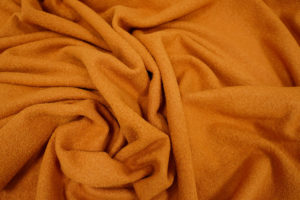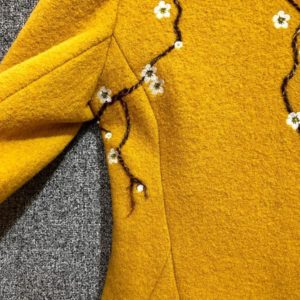Boiled wool is an excellent example of a successful collaboration between old and new technologies: while remaining natural, this fabric has acquired the ability to resist moisture and retain heat more reliably.
Having entered our market relatively recently, boiled wool has been successfully produced for the fourth hundred years. The material was invented by the Tyroleans, who have long worn woolen items in the harsh winter of the Austrian Alps. One day one of them washed his clothes in too hot water. To his surprise, the things did not deteriorate, but acquired new properties - they became softer and denser. And most importantly - any wind has ceased to be scary in them!
What is boiled wool?
This material is called loden. It is a felted material similar to classic cloth, but softer. The modern process of making loden differs from the previous one in the use of automated technology, everything else is the same as before:
 The wool sheared from sheep is washed and spun;
The wool sheared from sheep is washed and spun;- Wool fabric is obtained from fibers using the felting method - loose and lumpy;
- for smoothness and density, the material is boiled in boiling water with alkali (other chemistry is excluded);
- then comes the coloring stage - traditionally loden was green and blue, but now any color is possible;
- After drying, the fabric is combed out and sent to production.
Properties of boiled wool
Raw materials processed in this way acquire increased density, water-repellent properties and increased ability to retain heat. At the same time, the fabric retains the traditional qualities of natural sheep wool - it “breathes” and self-cleans. These properties distinguish Loden from similar fabrics.: as dense and moisture-resistant as felt, but much lighter; softer than felt and more windproof than drape.
Pros and cons of the material
Being natural and made in a special way, this canvas has many advantages:
 the density of boiled wool allows it to be used for winter clothing;
the density of boiled wool allows it to be used for winter clothing;- perfectly retaining heat and protecting from wind, the fabric remains “breathable” - it will not be hot;
- the characteristics of sheep wool provide water-repellent and self-cleaning properties of the material;
- the fabric is very plastic and can take any necessary shape of the clothing being modeled.
- the fabric cut does not require processing and does not crumble;
- The absence of aggressive chemicals in the production process ensures the environmental friendliness of the material.
If you decide to sew something from boiled wool, do not forget to decate the fabric before cutting. – wash (the water should be moderately hot), dry and steam. Otherwise, you can later end up with an item that is several sizes smaller than required - the material shrinks!
However, the advantages of loden can also turn into disadvantages.Thus, the mobility of its shape can eventually lead to the thing stretching under its own weight. You can’t wash it either in a machine or by hand - you can’t do without dry cleaning. The natural composition can result in an allergy to lanolin or other components.
Varieties of boiled wool
A variety of production methods made it possible to obtain different types of wool:
 impregnated or treated with a water-repellent composition;
impregnated or treated with a water-repellent composition;- unimpregnated;
- felted;
- felted-woven;
- felted;
- formed on a knitted base;
- with the addition of polyester.
The material surface options are also varied: it can be fleecy and smooth, one-sided and two-sided. It can be in the shape of a boucle, decorated with a pattern or embroidery. Sometimes mohair is added to create a lighter and softer material.
What can be made from boiled wool?
 The variety of material allows it to be used for sewing a wide variety of clothes. These can be demi-season and winter coats, jackets and cardigans. It makes excellent hats and gloves.
The variety of material allows it to be used for sewing a wide variety of clothes. These can be demi-season and winter coats, jackets and cardigans. It makes excellent hats and gloves.
A suit, dress or skirt - all this will fit into the wardrobe of a modern fashionista who values convenience and comfort. The fashion for textile bags leaves truly wide scope for the designer’s imagination! What about leg warmers - fashionable and warm?
When making clothes and accessories from boiled wool, glue the seams with non-woven fabric. Otherwise, the clothes will quickly lose their shape.
Subtleties of care
Having survived quite harsh processing, boiled wool remains a delicate fabric that requires special handling. The rules are simple, but they must be followed:
 do not give in to the temptation to wash the product: even careful hand washing can ruin the item;
do not give in to the temptation to wash the product: even careful hand washing can ruin the item;- Dry cleaning only is recommended;
- in between visits to the dry cleaner, you can clean the fabric with a dry brush, avoiding movements “against the grain”;
- The product can only be ironed from the inside out and through gauze;
- when sending an item for storage, it is packaged separately from other items in a paper bag (easily constructed from “craft” paper);
- Don’t forget to put a moth repellent in the bag – wormwood or tansy do an excellent job of protecting against voracious larvae.


 The wool sheared from sheep is washed and spun;
The wool sheared from sheep is washed and spun; the density of boiled wool allows it to be used for winter clothing;
the density of boiled wool allows it to be used for winter clothing; impregnated or treated with a water-repellent composition;
impregnated or treated with a water-repellent composition; do not give in to the temptation to wash the product: even careful hand washing can ruin the item;
do not give in to the temptation to wash the product: even careful hand washing can ruin the item; 0
0





